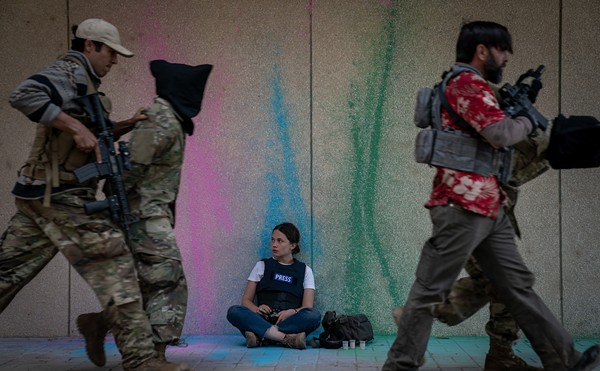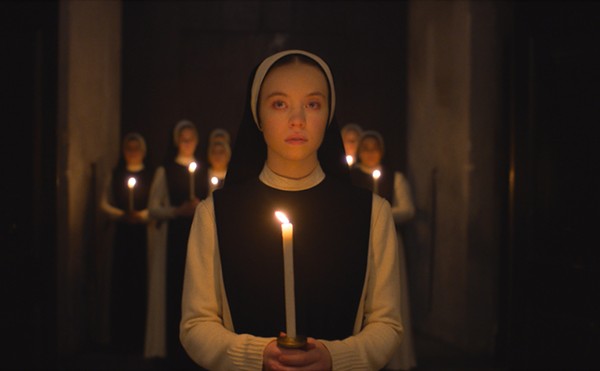The Cannes Film Festival (which ended its two-week run on Saturday) is nothing if not a study in contradictions. Studio product and tabloid fixtures — RPatz! KStew! "Le gentleman Brad," as one daily rag heralded the arrival of annual attendee Pitt — butt up on the red carpet against international unknowns, some representing the national cinemas of impoverished and/or war-torn nations. Future Oscar winners are unveiled on the ground floor of the Palais du Cinema as schlocky genre fare attracts buyers in the massive marketplace a floor below.
To grasp the vast ground Cannes covers between high and low, artistic integrity and commercial viability, consider the two films I saw consecutively before sitting down to write this. First came Post Tenebras Lux, a thrilling and mystifying non-linear nightmare stew of natural beauty, opaque symbolism and judicious provocation, its oblique subjectivity acknowledged via its literally blinkered perspective — it's shot in the square 4:3 aspect ratio, the image artificially blurred around the edges. That comes from Carlos Reygadas, whose last film, the stunning Mexican Mennonite family saga Silent Light — one of my picks for the best films of the past decade — won a jury prize here in 2007. Then came director Lee Daniels' follow-up to Precious, The Paperboy, a lurid late-60s-set swamp thing ostensibly about a social-justice-minded reporter (Matthew McConaughey) trying to free a convict (John Cusack) with help from the condemned man's death row groupie fiancee (Nicole Kidman) but more substantively about sex as self-destruction, and completely overcome by Daniels' own predilection for transforming would-be glamorous actresses into grotesques.
Reygadas and Daniels might seem to define two opposites of contemporary film production, but their Cannes entries had something in common: Both are unquestionably personal works rendered in their directors' idiosyncratic cinematic languages, and both were dismissed at Cannes as "unwatchable" by viewers who can't (or won't) hook into their specific wavelengths. Both will likely find their own cults in the "real" world, even as they drew boos at their press screenings and inspired debate as to whether they "deserved" their slots in competition.
That line of inquiry was perhaps more intense than usual this year, as the festival's main competition (as has been noted elsewhere exhaustively) did not include any features made by women — a deficiency which instigated a call for quotas, in essence suggesting the festival should be stripped of the right to determine its own identity.
Identities in limbo and in crisis were themes on-screen, too. The festival kicked off with Moonrise Kingdom, Wes Anderson's first Cannes competition entry, and the filmmaker's fullest expression yet of a personal style highly dependent on costuming as character shorthand and make-believe as a childish game that doesn't end but only mutates. Then Cannes rolled out one film after another dedicated to multiple roles/role-playing, the deceptive nature of appearances, and the blurry boundaries between the invented and the real.
Jacques Audiard's beautifully acted Rust and Bone, starring Marion Cotillard as a classy femme who loses both legs and Bullhead stud Matthias Schoenaerts as the pretty but apparently vacant thug she turns to for comfort, spends the bulk of its running time questioning facades and perceptions, then serves up a redemptive happy ending that would scan as total bullshit — if anything that had come before suggested that we were supposed to read it at face value.
The cheap melodrama that Rust and Bone takes as its form is arguably just a means to an end, but when it comes to adopting a formal guise for subversive purposes, Audiard's film doesn't hold a candle to the Director's Fortnight entry No. The third in a trilogy of films by Pablo Larrain dealing with the dictatorship of Augusto Pinochet (after Tony Manero and Post Mortem), No stars Gael García Bernal as an ad man contracted to create TV commercials advocating the "NO" vote in the 1988 referendum on Pinochet's presidency. The film includes appearances from real players in the campaign and was shot on video cameras vintage to the period, so actual excerpts from the real NO campaign could be woven into Larrain's fiction. The montage is seamless, and Larrain's faux-relic is convincingly uncanny.
Back in the competition, shape-shifting was further explored by a trifecta of meaty new offerings, from Korean master of soju-drunk studies of masculinity Hong Sang-soo, Iranian New Wave leader Abbas Kiarostami, and Frenchman Leos Carax, returning to Cannes with his first feature since Pola X in 1999.
Hong's meta-comedy In Another Country consists of three short stories featuring the same actors playing different characters. In each, Isabelle Huppert is cast as a visiting Frenchwoman (never the same one) who is pursued inappropriately, leading to several warnings about "that kind of Korean man," the kind whose foibles — including daytime drinking, bad sexual-decision-making, chronic obsession, and inability to learn from his mistakes — Hong specializes in plumbing for both comedy and pathos. The repetition of story elements reflects Hong's own tendency to do the same things over and over again, across his filmography and within individual films. Huppert is an outsider to Hong's world but a gifted actress who proves to be particularly adept at the goofy stuff. Her presence allows Hong to attack his usual themes from a new perspective. I found it more satisfying than Huppert's other Cannes 2012 entry, Michael Haneke's grueling "this is what it looks like to watch a loved one die" drama Amour, but Amour seems destined for the more substantive life domestically. It was instantly pegged on Twitter as the film to beat for next year's Foreign Language Oscar. (In that sweepstakes, don't count out Thomas Vinterberg's soggy comp entry, The Hunt).
Like Certified Copy in 2010, Kiarostami's Like Someone in Love takes mistaken and appropriated identity as a subject, but the film's own enigmatic, generic identity is itself constantly shifting — that's what makes it thrilling. Tracking a young Tokyo call girl's date with a much older man who later poses as her grandfather, the film is identifiably Kiarostamian in its long-take tableau and use of cars as portable interior locations. But it's also a sometimes baffling tonal and emotional roller coaster. Juxtaposing road-trip character study, screwball comedy, and near-noir — among other modes — Like Someone in Love concludes with a sudden act of violence, heralding the crumbling of facades within the movie and a breakthrough for its maker.
Although Kiarostami's film was incredibly divisive on the Croisette, the opposite was true of Carax's Holy Motors, a rapturously received journey into the night starring Denis Lavant as an actor (and assassin?) operating in a never-defined public theater of the absurd. Traveling Paris in the back of a white limo fitted with a vanity mirror and the makeup and costume resources of Universal Studios, Lavant's character (who goes by a number of monikers, including Alex and Oscar, variants of Carax's own given name) moves from one "assignment" to another, assuming new identities in a variety of elaborate costumes. In the most purely exhilarating sequence, Lavant re-dons his demented sewer-dwelling leprechaun costume from Carax's segment of the 2009 omnibus Tokyo! to kidnap a top model (played, incredibly, by Eva Mendes). He drags her to his lair where — naked, massive erection on display — he refashions her couture gown into a burka. That this doesn't play for shock value is indicative of the magical charm offensive Carax has pulled here. Threaded through with ruminations on performance and reception, vague verbal references to the eyes of unseen cameras and intercut references to early, pre-narrative film, Holy Motors is a kind of highly personal history of cinema — and a speculative suggestion of its future.





